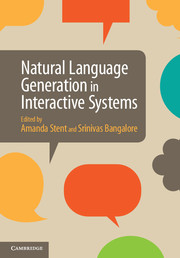Book contents
- Frontmatter
- Contents
- List of contributors
- 1 Introduction
- Part I Joint construction
- 2 Communicative intentions and natural language generation
- 3 Pursuing and demonstrating understanding in dialogue
- 4 Dialogue and compound contributions
- Part II Reference
- Part III Handling uncertainty
- Part IV Engagement
- Part V Evaluation and shared tasks
- Author index
- Subject index
- References
2 - Communicative intentions and natural language generation
from Part I - Joint construction
Published online by Cambridge University Press: 05 July 2014
- Frontmatter
- Contents
- List of contributors
- 1 Introduction
- Part I Joint construction
- 2 Communicative intentions and natural language generation
- 3 Pursuing and demonstrating understanding in dialogue
- 4 Dialogue and compound contributions
- Part II Reference
- Part III Handling uncertainty
- Part IV Engagement
- Part V Evaluation and shared tasks
- Author index
- Subject index
- References
Summary
Introduction
Natural language generation (NLG) has one significant disadvantage when compared with natural language understanding (NLU): the lack of a clear input format. NLU has as its starting point either a speech signal or text, both of which are well-understood representations. Input for NLG, on the other hand, is quite ill-defined and there is nothing close to consensus in the NLG community. This poses a fundamental challenge in doing research on NLG – there is no agreed-upon starting point.
The issue of input is particularly salient for NLG in interactive systems for one simple reason: interactive systems create their own communicative content. This is due to the role of these systems as dialogue partners, or conversational agents. The necessarily agentive nature of these systems requires them to decide why to speak and what to convey, as well as how to convey it.
Consider some other domains where NLG is used. In machine translation, for example, the system's job is to translate content from one human language to another. Here, the system does not have to create any content at all – that was already done by the human who created the source language text or speech. Work on automatic summarization is another example. Here the system's goal is to take pre-existing content and condense it.
Conversational agents, however, must create content. At a high level, this creation is driven by the need of the agent to communicate something. What the agent wants to accomplish by communicating is referred to as a communicative intention. If we can define communicative intentions, they can serve as a standard input representation to NLG for interactive systems.
- Type
- Chapter
- Information
- Natural Language Generation in Interactive Systems , pp. 13 - 33Publisher: Cambridge University PressPrint publication year: 2014

